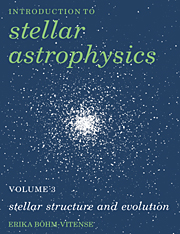Book contents
- Frontmatter
- Contents
- Preface
- 1 Introduction
- 2 Hydrostatic equilibrium
- 3 Thermal equilibrium
- 4 The opacities
- 5 Convective instability
- 6 Theory of convective energy transport
- 7 Depths of the outer convection zones
- 8 Energy generation in stars
- 9 Basic stellar structure equations
- 10 Homologous stars in radiative equilibrium
- 11 Influence of convection zones on stellar structure
- 12 Calculation of stellar models
- 13 Models for main sequence stars
- 14 Evolution of low mass stars
- 15 Evolution of massive stars
- 16 Late stages of stellar evolution
- 17 Observational tests of stellar evolution theory
- 18 Pulsating stars
- 19 The Cepheid mass problem
- 20 Star formation
- Appendix Radiative energy transport in stars
- Problems
- References
- Index
15 - Evolution of massive stars
Published online by Cambridge University Press: 08 January 2010
- Frontmatter
- Contents
- Preface
- 1 Introduction
- 2 Hydrostatic equilibrium
- 3 Thermal equilibrium
- 4 The opacities
- 5 Convective instability
- 6 Theory of convective energy transport
- 7 Depths of the outer convection zones
- 8 Energy generation in stars
- 9 Basic stellar structure equations
- 10 Homologous stars in radiative equilibrium
- 11 Influence of convection zones on stellar structure
- 12 Calculation of stellar models
- 13 Models for main sequence stars
- 14 Evolution of low mass stars
- 15 Evolution of massive stars
- 16 Late stages of stellar evolution
- 17 Observational tests of stellar evolution theory
- 18 Pulsating stars
- 19 The Cepheid mass problem
- 20 Star formation
- Appendix Radiative energy transport in stars
- Problems
- References
- Index
Summary
Evolution along the giant branch
Just as for low mass stars, the evolution of high mass stars is caused by the change in chemical composition when hydrogen fuses to helium. These stars, however, have a convective core such that the newly formed helium is evenly mixed throughout the core. When hydrogen is consumed, the convective core contracts and also shrinks in mass (because the κ + σ per gram decreases and therefore ∇r decreases); the mixing then occurs over a smaller mass fraction, while some material, which was originally part of the convective region, is left in a stable region but with a slightly enriched helium abundance and also a slight increase in the N14/C12 and C13/C12 ratios. (See Figs. 13.2 and 13.4.) When the convective core mass reduces further, another region with still higher helium abundance and higher N14/C12 and C13/C12 is left outside the convection zone. The remaining convective core becomes hydrogen exhausted homogeneously while it contracts to a smaller volume and becomes hotter. The stars also develop hydrogen burning shell sources around the helium core. Again the core acts like a helium star with a very high temperature; the temperature at the bottom of the hydrogen envelope becomes too high to sustain hydrostatic equilibrium in the hydrogen envelope. The envelope expands and the stellar surface becomes cooler, moving the star in the HR diagram towards the red giant region. Again an outer hydrogen convection zone develops and reaches into deeper and deeper layers. Finally it dredges up some of the material which was originally in the convective core when it included a rather large mass-fraction of the star.
- Type
- Chapter
- Information
- Introduction to Stellar Astrophysics , pp. 197 - 205Publisher: Cambridge University PressPrint publication year: 1992

